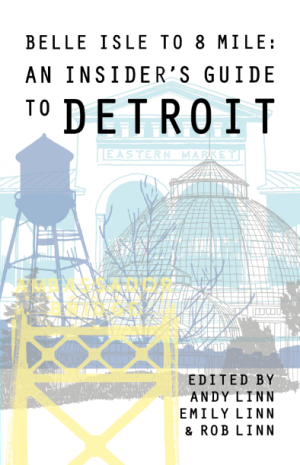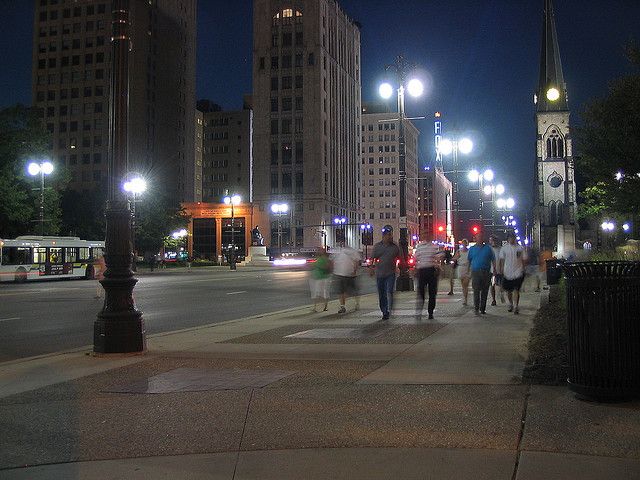This past December, the city of Detroit got its first comprehensive guidebook since the 1980s. Assembled and edited by a trio of siblings — Emily, Robert and Andrew Linn, all lifelong Detroiters from the city’s Lower East Side neighborhood — the book From Bell Isle to 8 Mile: An Insider’s Guide to Detroit features some 1,000 entries from more than 30 contributing writers.
Below, Robert Linn, an urban planner and data analyst who works for the non-profit Data Driven Detroit, talks about the process of pulling the book together, the response it has gotten from residents and visitors alike, and how the guide will, like the city it covers, expand and grow in the future.
Next City: So this is really the first Detroit guidebook in 30 years?
Robert Linn: We see it as the first comprehensive guidebook in 30 or more years. There have been guides to the city’s architecture, or the city’s restaurants. There’s a great guide for kids’ activities, and there’s a great guide to arts in the city. But this is the first one that includes a range of amenities and destinations.
NC: How did you go about filling in the gaps?
Linn: It was a very long process. I ended up driving about 3,000 miles in the city, and we did a lot of focus groups and surveys. We had a little box for suggestions that we took to public events like parades and festivals to create ideas. In my work as a planner, I’ve become sort of a data specialist, so I created a spreadsheet of several thousands things that someone had recommended to us, be it online or in person or in a focus group. And then we set out on actually visiting all of them to get a sense of what seemed most worthwhile to be in the book.

NC: How did you pick and choose what went into the book?
Linn: That was a challenge for us. There are many possible reasons something could be in the guide. It could be unique in the region, or very interesting, or [have] important architecture. In the book we have listings for everything from monuments to dive bars to soccer teams.
What was most important to us was to show a range of every type of business or cultural attraction. Obviously we can’t include every possible establishment, so we wanted to show a variety, but also what was most exceptional to us.
NC: Your book also offers a look at the history of different neighborhoods within Detroit. Besides the obvious way that this helps — finding what is located where — do you think it’s important for visitors to understand the city on that very local level?
Linn: Perhaps more so than in many cities, Detroit is really a city of neighborhoods, and every neighborhood was developed at a different period, with a different architectural style, for a different group of new residents arriving from different countries. As such, the city still has so many interesting remnants of these very, very different histories.
That was a point of pride for us: We really wanted to show that there are German beer halls and Danish bakeries and Polish sausage shops still there that are anchoring these neighborhoods that have evolved incredibly over the last 50-75 years. That history still informs and shapes the direction that these neighborhoods have taken since.
NC: One of the perennial Detroit narratives these days is the idea of journalists from outside the city parachuting in, gathering some grim images and anecdotes, and then writing a grim story about the state of the city. Obviously there’s more to Detroit than that. Do you see your book as playing a role in addressing, and maybe even changing, the way non-Detroiters perceive the city?
Linn: Detroit has a number of very real problems, and one of those is a problem of public perception. It seems to be so well known for its vacant land and ruinous buildings. The book tries to showcase many of the more positive things in the city — the hundreds of businesses and cultural attractions that make it unique — but equally important, the book tries to recontextualize those large, abandoned buildings. Rather than focusing on the dilapidation, [focus instead] on the history and architectural history.
NC: As someone who’s not from Detroit, usually when I see pictures of its vacant buildings, I don’t get that context. It usually devolves into what people like to call “ruin porn.” Is it your hope that, by providing historical and architectural context, you can spur some action to save and possibly rehab these buildings?
Linn: By increasing excitement about the city’s history and commercial heritage and activity, I think we can drive new businesses and create more awareness about many of the city’s beautiful historic buildings. This was certainly not my intention, but I would be very happy if the guide were able to spur the development of some of these structures and possibly the creation of new businesses. Anecdotally, I’ve already heard many examples of that going on, of the guide driving traffic to businesses in the city. I view that as a really positive thing.
NC: I noticed that you used Kickstarter to help fund the project, and it looks like you ended up raising more than double your goal. Do you think Detroiters were hungry for a book that straight up promotes the city, as opposed to one that focuses on its problems?
Linn: I feel as though it was partly about narrative, but at the same time it was about access to information. So many of our businesses have no phone number, no website, no Yelp review, no online presence. A big part of it was, people were hungry to see these sides of the city, but you really have to know someone to find out about them.
Many of the promotional materials put out by area organizations just showcase downtown Detroit, and then downtowns in suburban areas. It was really important for us to cover all of the city, all of its 139 square miles. The book really does cover every single neighborhood. That was a big point of interest among our buyers.
NC: Nowadays with different online tools — mapping tools, crowdsourcing tools — there’s really no reason for guidebooks to be as static as they once were. I was wondering if you tapped into any digital mapping or crowdsourcing tools in your effort to collect information.
Linn: We did not use any digital mapping tools. We did use several digital tools for just getting tabular submissions from residents and visitors, although we will certainly explore using Leaflet or another sort of tool to show some of the business and attractions in the book online in the near future.
We began with a book because it encourages immersive exploration of neighborhoods, and forces the reader to explore everything to find something of interest. Ultimately, it helped reach a broader audience. We’re certainly going to look to online content. Being an urban planner by trade, I’ll push for it to be a mapping-based platform.
NC: So would you consider From Belle Isle to 8 Mile a living document that people online, or wherever, can continue to contribute to?
Linn: Definitely. We’re planning on doing a second edition because we had so much overwhelming support for the first. But before we launch a second edition, we’re going to launch a website to both display reviews and information, but also to capture new ideas and recommendations. Already we’ve gotten a handful of new ideas about places in the guide, and I feel if we open that process up to the public at large, and not just to those who happen to notice our email address in the book, it will make the guide even better.







_600_350_80_s_c1.JPEG)








